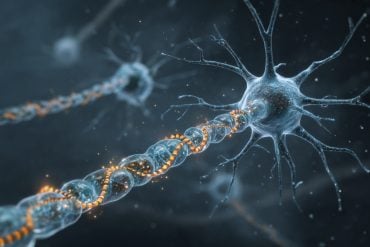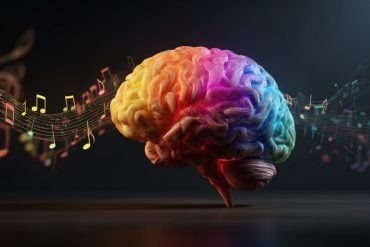Summary: Autonomic mimicry in human social interactions is significant, a new study reports. Researchers found in computer facial simulations where the pupils were dilated, test subjects trusted the simulated face more and mimicked the pupillary response.
Source: Leiden University
Synchrony in heart rate, skin conductance and pupil diameter plays a big role in human social interactions, such as gaining trust or being attracted toward each other. This is what Eliska Prochazkova found in several lab and field experiments. Ph.D. defense on 4 March 2021.
Imagine you’re in a theater, and on stage is your friend, giving a presentation. You notice she’s nervous; she’s blushing, she’s starting to sweat and her voice is beginning to tremble. And that’s when you involuntarily also start to feel nervous, without really knowing how to stop.
This is an example of autonomic mimicry, and how humans can ‘align’ with each other through non-verbal signals. Eliska Prochazkova researched the importance of autonomic mimicry (involuntary, non-visible responses such as skin conductance or pupil dilation) in human social interactions, and found that they are indeed very significant.
An exchange of signals
The exact role of autonomic mimicry in social interaction has been the subject of scientific debate: how does it fit in the process of human social interaction? Is mimicry a starting point, inducing certain emotions such as trust or attraction, or is it caused instead by these emotions?

“In fact,” says Prochazkova, ‘in my thesis I state that neither seems to be the case. Mimicry’s part of a larger exchange of verbal and non-verbal signals that seems to precede pro-social attitudes like trust or empathy. But our brains understand emotional signals and process them, and this can lead to “synchronization” or “alignment” between two humans and to other physiological or behavioral responses.”
Trust experiment
Until recently, social science was more focused on ‘larger’ motor movements in human interaction, such as facial expressions or body language. Thanks to modern techniques, such as electromyography, MRI scanning and the possibility to measure pupil diameter and eye movement, Prochazkova was able to conduct several lab and field experiments to discover the part that autonomic mimicry plays.
For instance, she set up a trust experiment in which subjects played a trust game with a computer simulation of a human partner, while their pupil diameter was measured. The results showed that in social interactions where the computer simulations’ pupils were larger, the subject trusted the simulation more and mimicked the pupil diameter of the simulation. In an interaction where the simulations’ pupils were smaller, the subjects seemed to trust the simulation significantly less.
No weddings
In another remarkable field experiment, Prochazkova set up a speed dating tent at the Dutch music festival Lowlands in an attempt to find a correlation between non-visible autonomous responses, the level of ‘synchronization’ between total strangers predicted whether they felt attracted to each other.
Here, she found that the greater the level of synchronization in heart rate and arousal levels, the more the subjects felt attracted to their partner. She laughs: “Unfortunately, no relationships grew out of our experiments. We weren’t invited to any weddings.”
Mimicry manipulation
Could we manipulate autonomic synchrony to make other people like us more or trust us? “The short answer is: we don’t know yet. We did conduct some experiments in our lab in which we tried to manipulate participants’ pupils by stimulating the brain stem, but this manipulation of pupil was not successful, so we do not have an answer yet. In a second experiment involving partially blocking someone’s sight, we did see that when the pupils of a interacting partner widened, this still subconsciously influenced trust of the participant. This implies that you don’t actually need a consciously perceive a signal for it to subconsciously influence your social behavior. But this is still research in development.”
However, Prochazkova will be moving her work in a new direction. Inspired by ‘real life’ experiments such as at Lowlands, she is now working on a project with the Leiden Institute for Brain and Cognition that involves using VR simulations to train the behavior of Dutch and Czech police officers during stressful situations.
About this neuroscience research news
Source: Leiden University
Contact: Jan Joost Aten – Leiden University
Image: The image is in the public domain
Original Research: Open access.
“Physiological synchrony is associated with cooperative success in real-life interaction” by F. Behrens et al. Scientific Reports
Abstract
Physiological synchrony is associated with cooperative success in real-life interaction
Cooperation is pivotal for society to flourish. To foster cooperation, humans express and read intentions via explicit signals and subtle reflections of arousal visible in the face.
Evidence is accumulating that humans synchronize these nonverbal expressions and the physiological mechanisms underlying them, potentially influencing cooperation. The current study is designed to verify this putative linkage between synchrony and cooperation.
To that end, 152 participants played the Prisoner’s Dilemma game in a dyadic interaction setting, sometimes facing each other and sometimes not. Results showed that synchrony in both heart rate and skin conductance level emerged during face-to-face contact. However, only synchrony in skin conductance levels predicted cooperative success of dyads. Crucially, this positive linkage was strengthened when participants could see each other.
These findings show the strong relationship between our bodily responses and social behavior, and emphasize the importance of studying social processes between rather than within individuals in real-life interactions.






